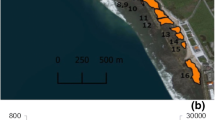Abstract
Ascophyllum nodosum (rockweed) is the main economic resource of the seaweed industry in the Atlantic Provinces of Canada. The annual harvest steadily increased since 1995, reaching a historic peak of 37,000 tonnes in 2007. Due to a high demand for fertilizers and animal feed supplements derived from rockweed, this trend seems likely to continue. The current management plan for the sustainable harvest of the A. nodosum resource is considered conservative. The resource has been managed with a precautionary approach since 1995 to protect the integrity of the habitat. Acadian Seaplants Limited (ASL) has been granted approximately 90% of the government-issued licenses to harvest A. nodosum resources in the Maritimes. The Canadian approach is based on an annual harvest from a given bed and not strip-and-return after several years. Since 1995, ASL has proactively undertaken extensive annual surveys and research on biomass productivity of this renewable resource to establish acceptable annual exploitation rates. Historically, the rockweed beds of southwestern Nova Scotia (NS) have been almost 99% pure A. nodosum, with a minor component of Fucus vesiculosus. However, since 2004, a steady increase in F. vesiculosus, with a peak of 4.6% of the total biomass in 2008, was recorded. This coincided with one of the mildest winters on record for the Maritimes. This increase in temperature seemed to be also responsible for an unusual recruitment of the blue mussel Mytilus edulis in rockweed beds in some areas of southern New Brunswick (NB) in 2006, causing the detachment of up to 30% of the seaweed biomass in some harvesting sectors. Another phenomenon observed in southwestern NS during 2003 and 2004 was extensive ice damage on rockweed beds produced by an early melting of the ice, with losses of up to 90% of the rockweed biomass in some areas.











Similar content being viewed by others
References
Dobretsov SV, Miron G (2001) Larval and post-larval vertical distribution of the mussel Mytilus edulis in the White Sea. Mar Ecol Prog Ser 218:179–187. doi:10.3354/meps218179
Lemaire N, Pellerin J, Fournier M, Girault L, Tamigneaux E, Cartier S, Pelletier E (2006) Seasonal variations of physiological parameters in the blue mussel Mytilus spp. from farm sites of eastern Quebec. Aquaculture 261:729–751. doi:10.1016/j.aquaculture.2006.08.017
McCook LJ, Chapman ARO (1991) Community succession following massive ice-scour on an exposed rocky shore: effects of Fucus canopy algae and of mussels during late succession. J Exp Mar Biol Ecol 154:137–169. doi:10.1016/0022-0981(91)90161-O
Sharp GJ (1986) Ascophyllum nodosum and its harvesting in Eastern Canada. In: Case studies of seven commercial seaweed resources. FAO Technical Report 281:3–46
Sharp GJ, Têtu C, Semple R, Jones D (1993) Recent changes in the seaweed community of Western Prince Edward Island: implications for the seaweed industry. Hydrobiologia 260/261:291–293. doi:10.1007/BF00049031
Ugarte R, Sharp GJ (2001) A new approach to seaweed management in eastern Canada: the case of Ascophyllum nodosum. Cah Biol Mar 42:63–70
Ugarte R, Sharp GJ, Moore B (2006) Changes in the brown seaweed Ascophyllum nodosum (L.) Le Jol., plant morphology and biomass produced by cutter rake harvests in southern New Brunswick, Canada. J Appl Phycol 18:351–359. doi:10.1007/s10811-006-9044-8
Acknowledgments
We would like to express our appreciation to two anonymous reviewers for useful comments made on the manuscript. Joshua Sharp provided valuable support during data collection. Dr. Joel Chassé provided some valuable graphs with oceanographic data.
Author information
Authors and Affiliations
Corresponding author
Additional information
This paper was presented at the 3rd Congress of the International Society for Applied Phycology, Galway.
Rights and permissions
About this article
Cite this article
Ugarte, R.A., Critchley, A., Serdynska, A.R. et al. Changes in composition of rockweed (Ascophyllum nodosum) beds due to possible recent increase in sea temperature in Eastern Canada. J Appl Phycol 21, 591–598 (2009). https://doi.org/10.1007/s10811-008-9397-2
Received:
Revised:
Accepted:
Published:
Issue Date:
DOI: https://doi.org/10.1007/s10811-008-9397-2




